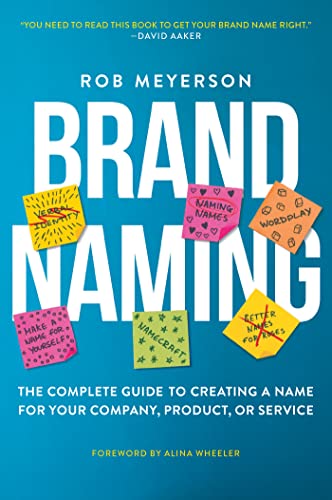In Brand esSense I argued that a brand name was the most important ‘symbol’ of a brand and its meaning. The name primes other associations with a brand and is often the most consistently used brand expression across multiple touchpoints. When I wrote Brand esSense there was a small literature on the topic of brand names, including books by Rivkin & Sutherland and Merriam (see references below).
Many brand names become categories – think of biros cellophane, thermos, cornflakes, granola, yo-yos and even heroin. Brand names can be difficult to translate into other languages, although when used effectively become a key brand asset (think of McDonalds use of McNames). The sound of the name can be very important too (blackberry is faster to speak than strawberry, and FedEx also implies speed).
Identifying a name that is distinctive, and can also create meaning, is challenging, which is why I was happy to see the new book by Rob Meyerson. Brand Naming really does do ‘what it says on the tin’ in being a complete guide to creating a name for any company, product or service.
Rob Meyerson starts with the basics of how brand naming works and what makes a good brand name. He cites nine qualities of good names, including those that are strategic (meaningful, adaptable, distinctive), those that are creative (memorable, sounds good, looks good) and those that are technical (legally available, linguistically viable, easy to spell and pronounce). He uses Apple, Swiffer and Kodak as examples of good names, and over-explanation, inside jokes and trendchasers as some of the sins of bad names.
The next chapter talks about types of brand names, discussing naming approach and naming construct as two dimensions. Naming approach covers descriptive to suggestive to abstract, while naming construct includes real-world, compound and coined names (i.e., newly invented words).
Rob Meyerson then takes us through each step of the naming process, starting with a brief, generating names, shortlisting, screening, presenting, legal search and final selection. At each stage he offers good advice and templates to use. For example, there is much more to a good brief than describing what is being names. What are the ideas and meanings that should be conveyed, what feelings should be evoked, who are the target audience and what is the competitive landscape?
In the chapter on generating names, the author makes good use of mind maps and other creative tools to help explore different potential ideas. He offers resources and advice on trademarks and screening of names and linguistic checks. He also emphasizes the importance of focusing on getting the right name before getting a specific domain name.
This is a great overview of the naming process and a great resource for any company, big or small. Finding the right name can make a big difference in any business, and the author aptly quotes Adam Alter at the front of the book, “As soon as you label a concept, you change how people perceive it.”
REFERENCES
The Making of a Name: The Inside Story of the Brands We Buy by Rivkin & Sutherland
Merriam’s Guide to Naming by Lisa Downey Merriam
Brand esSense by Neil Gains
Brand Naming: The complete guide to creating a name for your company, product or service by Rob Meyerson






